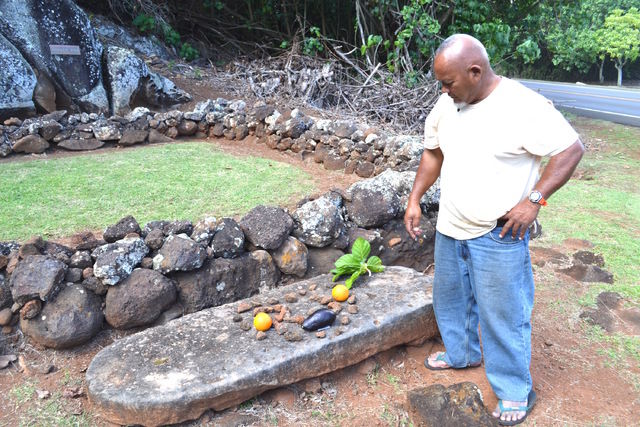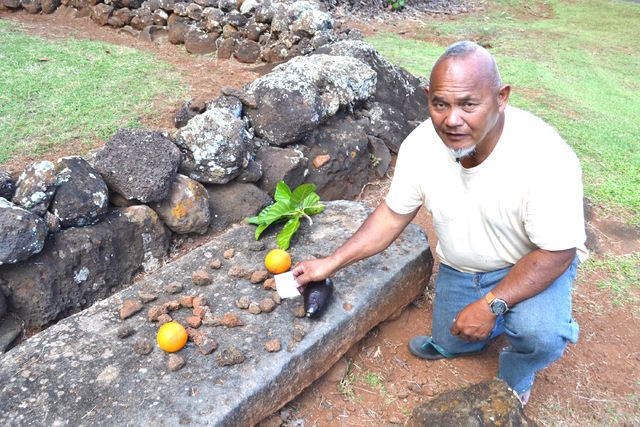WAILUA — The birth site of Kauai’s last king was desecrated Thursday morning, stewards of the heiau told The Garden Island. James Alalem, a steward of Holoholuku Heiau since the early 1980s, said the birthplace of King Kaumualii was disrespected
WAILUA — The birth site of Kauai’s last king was desecrated Thursday morning, stewards of the heiau told The Garden Island.
James Alalem, a steward of Holoholuku Heiau since the early 1980s, said the birthplace of King Kaumualii was disrespected after Alalem discovered sacred rocks out of place, fruits offered and a cryptic note left at the area.
“The sacredness is disrupted. When you give offering, it’s not of objects. It’s a prayer. You don’t leave things. It’s not the right way,” Alalem said. “Everything should be left with the way it is.”
The note, which says, “Your revenge is complete. Your debt is yours,” is interpreted by the 59-year-old as “one of the worst desecrations” he’s seen at the heiau.
“This is one of many (disrespectful acts), but this one is more upsetting because they left a letter of cursing. This is a place of birth, of life,” he said.
Heiau or temples are sacred in the Hawaiian culture. It represents the genealogy of the Hawaiian people and tells the history of its storied past, Alalem said.
“It’s very important to remember your past, so stone enclosures like this is blessed by the kahuna,” he said. “Each stone you see was carried by hand and wasn’t placed until it reached the heiau.”
Noa Noamau, a Wailua resident and an heir to King Kaumualii, regrets not being there to educate the person or persons who desecrated the site.
“If you travel to China for example, you’re going to disrespect their temple and their culture,” he said. “I feel Hawaiians deserve the same thing for our land, our culture, our people.”
Pohaku or rocks were also arranged to form the initials “R.J.” The touching of the rocks is also considered kapu or forbidden.
Alalem and Noamau don’t know what the initials mean or who desecrated the site.
The offering was made on a sandstone that was used to enter the birthing area. Only alii or royalty were allowed to touch the sandstone, Alalem said. In the past, commoners who touched the sandstone were put to death on the spot.
“Underneath that stone is the bones of a dog,” he said. “Only the Hawaiian alii could eat the dog. When you find dog bones, that was a sign to let the common people know that was alii.”
Kamuela Hepa Kapule O Kamehameha was at the site cleaning brush on Thursday.
He said the stewards of the area perpetuate the Hawaiian culture by cleaning and taking care of the land.
“The land takes care of us: It feeds us and nurtures us. It gives us everything we need in a sustainable situation,” he said. “This is our historical site and in our family historical rights, also.”
Alalem said it’s important to understand sacredness of heiau to the Hawaiian culture.
In the past, he witnessed people standing on the heiau, being massaged naked on the rocks and even discovered trash and dirty diapers there.
“The culture is for the children and for the culture,” he said. “People forget about the sacredness of this area. Without the history, there is no future. Out of the many offerings that was put here, this is the worst I’ve seen.”
He said if visitors are to leave an offering, the offering comes from your own mana, from yourself.
“Stay out a distance from the walls. Don’t touch the stones. You only can look at them,” he said. “If you want to leave a hookupu, an offering, all you need to do is say a little prayer. You don’t have to leave anything.”



